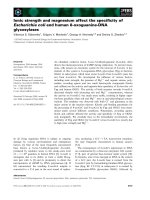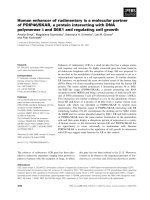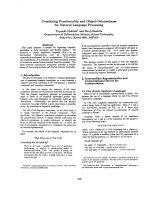Báo cáo khoa học: "Human endotoxemia and human sepsis: limits to the mode" ppt
Bạn đang xem bản rút gọn của tài liệu. Xem và tải ngay bản đầy đủ của tài liệu tại đây (37.86 KB, 2 trang )
151
Available online />Abstract
Sepsis remains the most common cause of death in intensive care
units of the developed world. Accurate models of this disease
syndrome are crucial for to the understanding of the complex
pathophysiology of this disorder. The administration of a small
dose of lipopolysaccharide to healthy volunteers is one such model
of spontaneous human sepsis. Although this human endotoxemia
model appears to be reasonably effective in mimicking early
biochemical, metabolic, hematologic and cardiovascular septic
responses in septic shock, the ability to mimic other aspects of
human sepsis is open to question. The current study demonstrates
that human experimental endotoxemia fails to generate evidence of
increased vascular permeability within the relatively short time
frame of the study.
Sepsis continues to be the most common cause of death in
nonsurgical intensive care units. The mortality rate has
remained high and substantially unchanged over the past
century [1]. Recently, there has been a flurry of investigative
work demonstrating the clinical benefit of certain
interventions for sepsis, severe sepsis and septic shock [2].
The studies documenting improved outcomes with these
therapies were borne of earlier efforts to elucidate the
pathophysiology of this complex disease.
Much of the initial research effort focused on the
development of appropriate models of disease. Early models
of sepsis involved the rapid administration of large doses of
endotoxin or live bacteria to experimental animals [3,4].
Subsequently, models involving cecal ligation/perforation and
peritoneal implantation of infected clots were shown to mimic
some aspects of sepsis more accurately [3]. However, both
are necessarily imperfect in that human responses cannot be
examined. The development of a human model of endo-
toxemia utilizing rapid administration of 4 ng/kg of reference
endotoxin solved this problem. This model of endotoxemia
has been used to examine a wide range of inflammatory,
hemostatic, cardiovascular and respiratory responses
characteristic of spontaneous sepsis in humans [5–14].
However, the integration of human responses into an
endotoxemia model also creates necessary limitations. No
such human model can mimic all of the critical elements
present in spontaneous human sepsis.
In this issue, van Eijk and colleagues [15] test the utility of
this model of human endotoxemia in the examination of
microvascular permeability alterations characteristic of sepsis
and septic shock. Despite meticulous effort, they were unable
to support the current widely used human endotoxemia
model as a suitable proxy for study of the septic
microvascular permeability responses.
Three separate methods were used by the authors to
measure vascular permeability: transcapillary escape rate of
I
125
-albumin, venous occlusion strain-gauge plethysmo-
graphy, and bioelectrical impedance analysis. No statistical
difference in vascular permeability between those who
received endotoxin and control individuals receiving placebo
was noted, despite the significant divergence of the two
groups in proinflammatory cytokine and cardiovascular
responses. The authors concluded that the human endo-
toxemia model is inadequate for study of the pathophysiology
of capillary leak in sepsis.
There are significant qualifiers in regard to the findings
reported by van Eijk and coworkers. First, as the authors
themselves note, the dose of endotoxin used may have been
suboptimal to induce capillary leakage. Although the typical
cardiovascular response was indeed seen, most of the
previous studies utilized twice the dose (i.e. 4 ng/kg) that was
used by van Eijk and colleagues [5,6,11–13]. Furthermore
the cardiovascular changes seen by Suffredini [11] and
Kumar [13] and their colleagues appear to have been much
more profound that those observed by van Eijk and co-
workers, suggesting that, despite the seemingly adequate
Commentary
Human endotoxemia and human sepsis: limits to the model
Ramon Anel
1
and Anand Kumar
2
1
Assistant Professor, Section of Critical Care Medicine, Section of Nephrology, University of North Dakota, Grand Forks, North Dakota, USA
2
Associate Professor, Section of Critical Care Medicine, Section of Infectious Diseases, University of Manitoba, Winnipeg, Canada, and University of
Medicine and Dentistry, UMDNJ, Camden, New Jersey, USA
Corresponding author: Anand Kumar,
Published online: 4 March 2005 Critical Care 2005, 9:151-152 (DOI 10.1186/cc3501)
This article is online at />© 2005 BioMed Central Ltd
See related research by van Eijk et al. in this issue [ />152
Critical Care April 2005 Vol 9 No 2 Anel and Kumar
cytokine response, the cardiovascular (and perhaps permea-
bility) effects may be dose dependent.
Second, although early vascular dysfunction with
venodilatation is typical of experimental endotoxemia and
septic shock, more prolonged inflammatory stimulation may
be required for major vascular permeability increases (even
though both responses may be mediated by nitric oxide
generation [16–18]). If this is the case, then the duration of
the inflammatory stimulus induced by transient endotoxemia
might also have been insufficient to induce the increase in
vascular permeability seen in clinical sepsis.
Third, insufficient exogenous fluids might have been
provided. In their human endotoxemia studies, Suffredini
[11] and Kumar [13] and coworkers, for example, infused
anywhere from 3 to 5 l of crystalloid over a period of about
5 hours. In comparison, the volunteers included in the study
by van Eijk and coworkers [15] only received 375 ml over
5 hours. Furthermore, Suffredini and colleagues [6]
detected a difference in pulmonary gas exchange only after
more than 2 l of saline was infused to individuals given
endotoxin, suggesting that endotoxemia by itself may be
inadequate to elicit a detectable increase in capillary
permeability.
A final possibility, of course, is that the human endotoxemia
model simply fails to replicate the conditions of sepsis, as
seen in spontaneous human or animal disease. Noninfectious
models of septic shock typically involve bacterial toxins or
proximal endogenous mediators such as tumor necrosis
factor-α. Even infusion of live organisms can represent toxin
model equivalents if the infused organism is of low virulence.
For example, many such models use laboratory strains of
highly serum-sensitive organisms. In these cases, the
replicative component of infection is missing. Although one
difference between such models and those involving live
infection at a focal site may be the degree to which the
inflammatory stimulus is sustained, other important
differences may also exist that could explain the failure to
generate increased vascular permeability in the human
endotoxemia model. These could potentially include specific
bacterial structural antigens (e.g. bacterial DNA) or exotoxins
that are not found in noninfectious models.
Regardless, although one can argue that the conclusions
drawn by van Eijk and coworkers may be somewhat too
sweeping, they do raise valid questions that ultimately need
to be answered if we are to advance our understanding of the
pathophysiology of microvascular leakage in sepsis. What
roles do the endothelium and interstitium play in capillary
permeability in the setting of sepsis? Which mediators are
responsible for microvascular leak? Can the serum kinetics of
these mediators have an impact on the permeability
response? How does the endothelium interact and modulate
responses to potential mediators?
Although the answers to these questions will invariably be
found in the basic science laboratory, the final arbiter of
clinical relevance is the application of the same in humans. To
paraphrase from William E Paul, no experimental model can
settle the empirical issue of clinical medicine.
Competing interests
The author(s) declare that they have no competing interests.
References
1. Chaudry IH: Sepsis: lessons learned in the last century and
future directions. Arch Surg 1999, 134:922-929.
2. Dellinger RP, Carlet JM, Masur H, Gerlach H, Calandra T, Cohen
J, Gea-Banacloche J, Keh D, Marshall JC, Parker MM, et al.: Sur-
viving sepsis campaign guidelines for management of severe
sepsis and septic shock. Crit Care Med 2004, 32:858-873.
3. Deitch EA: Animal models of sepsis and shock: a review and
lessons learned. Shock 1998, 9:1-11.
4. Lagoa CE, de Figueiredo LF, Cruz RJ Jr, Silva E, Rocha e Silva M:
Effects of volume resuscitation on splanchnic perfusion in
canine model of severe sepsis induced by live Escherichia
coli infusion. Crit Care 2004, 8:R221-R228.
5. Hesse DG, Tracey KJ, Fong Y, Manogue KR, Palladino MA Jr,
Cerami A, Shires GT, Lowry SF: Cytokine appearance in human
endotoxemia and primate bacteremia. Surg Gynecol Obstet
1988, 166:147-153.
6. Suffredini AF, Shelhamer JH, Neumann RD, Brenner M, Baltaro
RJ, Parrillo JE: Pulmonary and oxygen transport effects of
intravenously administered endotoxin in normal humans. Am
Rev Resp Dis 1992, 145:1398-1403.
7. Catania A, Suffredini AF, Lipton JM: Endotoxin causes release
of alpha-melanocyte-stimulating hormone in normal human
subjects. Neuroimmunomodulation 1995, 2:258-262.
8. von der Mohlen MA, Kimmings AN, Wedel NI, Mevissen ML,
Jansen J, Friedmann N, Lorenz TJ, Nelson BJ, White ML, Bauer R,
et al.: Inhibition of endotoxin-induced cytokine release and
neutrophil activation in humans by use of recombinant bacte-
ricidal/permeability-increasing protein. J Infect Dis 1995, 172:
144-151.
9. Pajkrt D, Doran JE, Koster F, Lerch PG, Arnet B, van der Poll T,
ten Cate JW, van Deventer SJ: Antiinflammatory effects of
reconstituted high-density lipoprotein during human endotox-
emia. J Exp Med 1996, 184:1601-1608.
10. Suffredini AF, Harpel PC, Parrillo JE: Promotion and subsequent
inhibition of plasminogen activation after administration of
intravenous endotoxin to normal subjects. N Engl J Med 1989,
320:1165-1172.
11. Suffredini AF, Fromm RE, Parker MM, Brenner M, Kovacs JA,
Wesley RA, Parrillo JE: The cardiovascular response of normal
humans to the administration of endotoxin. N Engl J Med
1989, 321:280-287.
12. Michie HR, Manogue KR, Spriggs DR, Revhaug A, O’Dwyer S,
Dinarello CA, Cerami A, Wolff SM, Wilmore DW: Detection of
circulating tumor necrosis factor after endotoxin administra-
tion. N Engl J Med 1988, 318:1481-1486.
13. Kumar A, Bunnell E, Lynn M, Anel R, Habet K, Neumann A, Parrillo
JE: Experimental human endotoxemia is associated with
depression of load-independent contractility indices: preven-
tion by the lipid a analogue E5531. Chest 2004, 126:860-867.
14. Preas HL II, Jubran A, Vandivier RW, Reda D, Godin PJ, Banks
SM, Tobin MJ, Suffredini AF: Effect of endotoxin on ventilation
and breath variability: role of cyclooxygenase pathway. Am J
Respir Crit Care Med. 2001, 164:620-626.
15. van Eijk LTGJ, Pickkers P, Smits P, van den Broek W, Bouw
MPWJM, van der Hoeven JG: Microvascular permeability
during experimental human endotoxemia: an open interven-
tion study. Crit Care 2005, 9:R157-R164.
16. Kubes P: Nitric oxide modulates microvascular permeability.
Am J Physiol. 1992, 262:H611-H615.
17. Wang le F, Patel M, Razavi HM, Weicker S, Joseph MG, McCor-
mack DG, Mehta S: Role of inducible nitric oxide synthase in
pulmonary microvascular protein leak in murine sepsis. Am J
Respir Crit Care Med 2002, 165:1634-1639.
18. Vane JR, Anggard EE, Botting RM: Regulatory functions of the
vascular endothelium. N Engl J Med 1990, 323:27-36.









